Hyundai
Tucson Rear Disc Brake Pads Replacement Guide
How to change the rear disc brake pads on
a 2nd generation 2010 to 2015 Hyundai Tucson SUV with photo illustrated steps.
 2014 Tucson Rear Wheel |
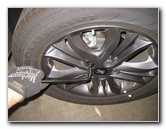 Slightly Loosen 5 Lug Nuts |
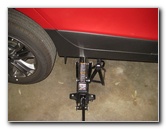 Raise Rear of Vehicle |
| This
automotive maintenance tutorial was specifically written to assist
owners of the 2nd generation (2010, 2011, 2012, 2013, 2014 & 2015)
Hyundai Tucson SUV in changing the rear disc brake pads and
lubricating the caliper slider pins. Owners of other Hyundai and Kia vehicles such as the Accent, Elantra, Sonata, Azera, Veloster, Tiburon, Genesis, Lavita, Veracruz, Santa Fe, ix35, Equus, Cadenza, Forte, Optima, Rio, Soul, Sedona, Sorento, Spectra and Sportage may also find these DIY instructions to be helpful. The tools needed to complete this procedure include a floor jack, two jack stands, a lug nut wrench, a 14mm socket, a 3/8" drive ratcheting wrench, a "C" or "F" clamp and a tube of brake parts lubricant grease. The compatible replacement brake pad part numbers may vary depending on the model year and whether your Tucson is a "FWD" (front wheel drive) or "4WD" (four wheel drive) model. |
||
|
|
||
A few compatible replacement sets of rear brake pads with their part numbers include the following: ACDelco 14D1157CH, Wagner ThermoQuiet QC1398, Bendix D1157 CQ, Hyundai 58302-2SA00, TRW TPC1398, Dura International BP1157 C, Monroe CX1398 and KFE KFE1398-104.
|
||
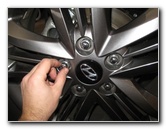 Spin Off 5 Lug Nuts |
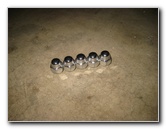 5 Lug Nuts Removed |
 Caliper, Bracket & Rotor |
| The first few steps
are to park the SUV on a level surface, make sure that the emergency /
parking brake is not engaged and chock the front wheels to prevent it
from moving. Then slightly loosen the five lug nuts on the rear wheel by turning them counterclockwise with the tire iron. Raise the rear of the SUV with the floor jack and securely support it with the two jack stands. I prefer to work on one side of the car at a time to keep three wheels on the ground for extra safety. Spin off the 5 lug nuts and set them aside in a safe place. Remove the rear wheel to reveal the caliper, bracket, rotor and suspension. |
||
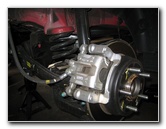 Rear Brake Caliper |
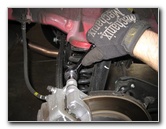 Loosen Upper Caliper Bolt |
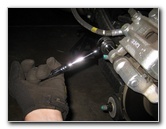 Loosen Lower 14mm Bolt |
| The rear brake
caliper is held in place to the bracket by two bolts on the back side. Loosen the upper caliper bolt by turning it clockwise (as seen from the outside of the vehicle) with the 14mm socket and 3/8" drive ratcheting wrench. Then loosen the lower caliper bolt by turning it clockwise (as seen from the outside of the vehicle) with the 14mm socket and 3/8" drive ratcheting wrench. |
||
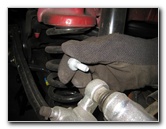 Spin Out Upper Bolt |
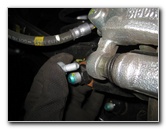 Remove Lower 14mm Bolt |
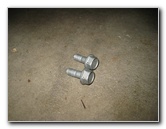 Two 14mm Caliper Bolts |
| Spin out the two caliper bolts and set them aside in a safe place. | ||
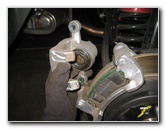 Pull Off Rear Caliper |
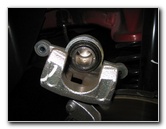 Rest Caliper On Suspension |
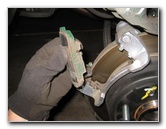 Remove Old Outer Pad |
| Pull the rear brake
caliper out of the bracket and off the old pads. Carefully rest the caliper on the suspension or suspend it from the spring with a bungee cord. Pull the old inner and outer brake pads out of the bracket. I recommend buying the Wagner ThermoQuiet QC1398 brake pads since they have excellent reviews on Amazon. I also like how they don't require any backing plates, shims or disc brake quiet gel due to the built in insulators. |
||
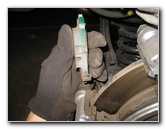 Wear Bar - Bottom Inner Pad |
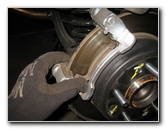 Replace Pad Abutment Clips |
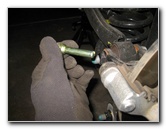 Pull Out Caliper Slider Pins |
| Make a mental note
of where the wear indicator or "squeal" bar is located on the old brake
pads.
On this 2014 Tucson FWD (front wheel drive) model, the wear bar was situated at the bottom of the inner brake pad. If your set of new rear brake pads included replacement brake hardware, pull the old metal pad abutment or "anti-rattle" clips out of the top and bottom of the bracket and install the new ones in their place. In order for the caliper to operate smoothly, the two caliper slider pins inside the bracket need to be well lubricated. Pull the caliper slider pins out of their rubber dust boots, apply a thin layer of high temperature brake caliper grease to each before pushing them back in to their dust boots. |
||
|
|
||
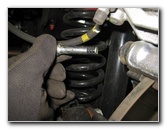 Lubricate & Replace Pins |
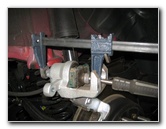 Attach "F" Clamp To Caliper |
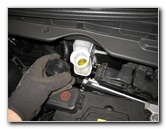 Twist Off Brake Fluid Cap |
|
In order for the caliper to fit over the thicker new brake pads, the caliper
piston needs to be compressed back. Attach the "C" or "F" clamp to the caliper using the back of an old brake pad to evenly distribute the pressure across the piston. Move to the right rear area of the engine bay, near the driver's seat, and twist off the brake fluid reservoir cap in the counterclockwise direction. Slowly turn the "F" clamp's handle in the clockwise direction to push the piston back while repeatedly checking the level in the brake fluid reservoir to make sure it doesn't overflow. Clean up any spilled brake fluid immediately with a rag and flush the area with water. Brake fluid can easily damage automotive paint. |
||
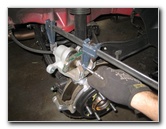 Compress Back Caliper Piston |
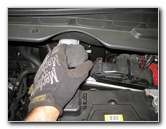 Replace Brake Fluid Cap |
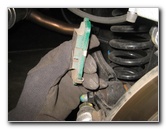 Wear Bar - Bottom Inner Pad |
| Compress back the
caliper piston until it is flush with its rubber dust boot.
Try to avoid pinching or otherwise damaging the rubber dust boot surrounding the piston. Replace the brake fluid reservoir cap as soon as possible since brake fluid is hygroscopic (readily absorbs moisture from the air). Thoroughly clean off the brake rotor, caliper bracket, brake caliper assembly and the lug nut studs with brake parts cleaner spray. Do not use compressed air or blow with your mouth to clean off the brake parts since breathing in brake dust can be harmful to your health. Brake dust can be carcinogenic (causes cancer) if inhaled.
To remove the existing rotors and install new ones, remove the two bolts on the rear of the caliper bracket that attach it to the steering knuckle. Then loosen the old rotor with a rubber mallet, pull it off, and slide the new one in its place. Apply a thin layer of brake caliper grease to any area where there is metal to metal contact such as the outer lip of the caliper piston. Do not apply brake parts lubricant to the friction surface of the new pads or to the rotor. Install the new brake pads in to the caliper bracket with the wear indicator bar situated at the bottom of the inner brake pad. |
||
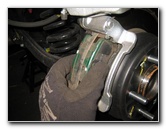 Push Pads Against Rotor |
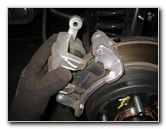 Lower Caliper Over Pads |
 Spin In Caliper Bolts |
| Push the two new
brake pads flush against the rotor. Carefully lower the caliper down over the new brake pads and in to the bracket. If the caliper won't fit over the new pads, you probably just need to compress the piston back a bit further. Line up the bolt holes in the caliper with their corresponding bolt holes in the slider pins within the bracket. Re-insert the two caliper bolts and spin them in a few turns by hand in the counterclockwise direction (as seen from the outside of the vehicle) to prevent them from becoming cross threaded. |
||
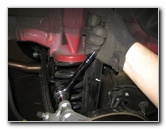 Tighten Counterclockwise |
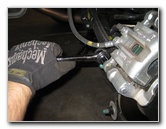 Tighten Lower Caliper Bolt |
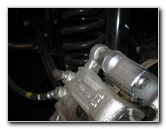 Rubber Valve Cover |
|
Tighten the upper and lower caliper bolts by turning them counterclockwise
with the 14mm socket and 3/8" drive ratcheting wrench to just past hand
tight or about 20-25 ft-lbs of torque. Double check that the two caliper bolts are tight before moving on to the next steps. |
||
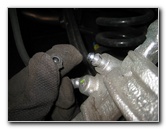 Brake Fluid Bleeder Valve |
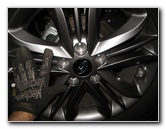 Push On Rear Wheel |
 Spin On 5 Lug Nuts |
|
If your brake pedal previously felt soft or spongy, the brake fluid may be contaminated with water or the brake lines may contain some air bubbles. It would be best to bleed the brake lines at this time in order to flush out the old fluid and replace it with fresh DOT 3 or 4 brake fluid. For more on this topic, check out my Brake Line Fluid Bleeding With An Assistant DIY Guide or alternatively the Brake Line Fluid Bleeding With A Power Bleeder Guide. The brake fluid bleeder valve is located underneath a rubber cap on the back side of the caliper just below the upper caliper bolt. Replace the rear wheel and spin on the 5 lug nuts by hand in the clockwise direction to prevent them from becoming cross threaded. |
||
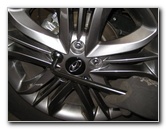 Slightly Tighten Clockwise |
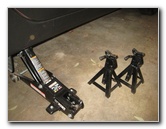 Lower SUV From Stands |
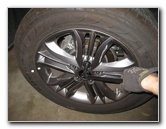 Torque Lug Nuts 65-80 ft-lbs |
|
Slightly tighten the 5 lug nuts in a "criss cross" or "star" pattern with
the tire iron. Carefully lower the SUV from the jack stands using the floor jack. Continue progressively tightening the 5 lug nuts in a "criss cross" or "star" pattern to about 1/8 to 1/4 turn past hand tight or about 65.1 to 79.5 ft-lbs of torque. It would be best to use a torque wrench or an impact wrench with a torque stick to properly tighten the lug nuts. Sit in the driver's seat of the vehicle and firmly press the brake pedal a few times to restore the brake line pressure. Check the brake fluid in the reservoir and verify that it is at the proper level. If it is low, pour in some fresh DOT 3 or DOT 4 fluid. To break in your new rear brake pads, just drive normally for the first few hundred miles while trying to avoid any hard or "panic" stops which may glaze over the new pads and cause them to be noisy and/or not perform as well. It's also a good idea to regularly check your driveway for drops of brake fluid which may indicate a leak, check the brake fluid level in the reservoir, and also verify that all the lug nuts are still tight. For more,
check out my other
Hyundai Tucson DIY Repair & Maintenance Guides. |
||
| If you found this guide to be helpful,
please consider making a small donation by clicking on the PayPal.com
"Donate" button located to the right of this paragraph. Thank you!
(Note: I am not a registered charity. Donations are not tax deductible.) |

